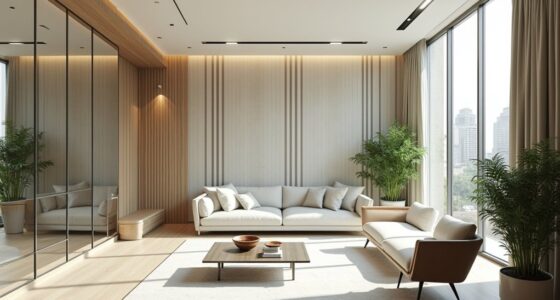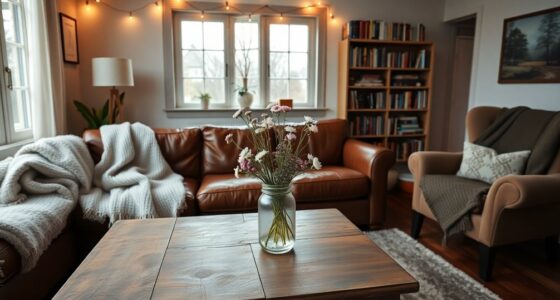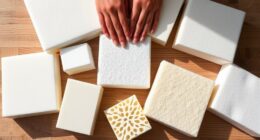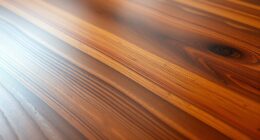Modern design focuses on minimalism, clean lines, and functionality, emerging from industrialization in the late 19th century. It embraces innovation and often features eco-friendly materials and open spaces. In contrast, classic design draws inspiration from historical architecture, offering ornate details, rich textures, and a timeless appeal. This style evokes nostalgia and showcases craftsmanship from the 18th and 19th centuries. While modern design promotes new ideas and sustainable practices, classic design reflects cultural heritage. Both styles can blend harmoniously in your space, creating a unique atmosphere. Discover more about how these designs can complement each other for a balanced aesthetic.
Key Takeaways
- Aesthetic Approach: Classic design features ornate details and rich textures, while modern design emphasizes minimalism and clean lines for a simpler look.
- Color Palette: Classic design uses warm neutrals and deep tones, whereas modern design favors a neutral palette with occasional bright accents for a serene feel.
- Material Usage: Classic design relies on natural materials for warmth, while modern design incorporates innovative materials like glass and metal for a sleek appearance.
- Space Layout: Classic design often features defined, traditional layouts, while modern design promotes open floor plans to maximize light and space.
- Historical Context: Classic design reflects historical craftsmanship and heritage, while modern design embodies innovation and contemporary lifestyle influenced by industrialization.
Definitions of Design Styles
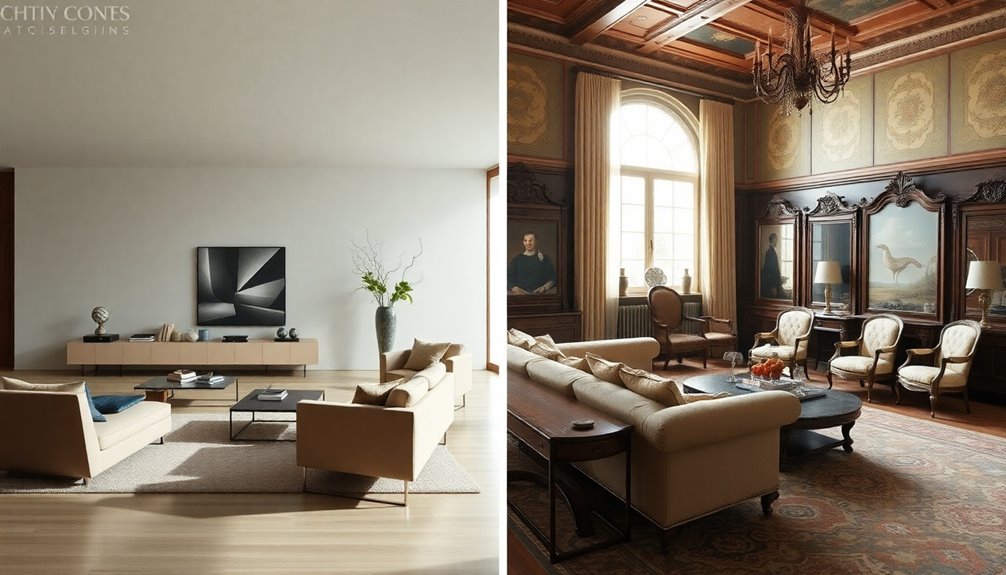
When you think of design styles, two prominent categories often come to mind: modern and classic.
The modern design style emerged from the late 19th to mid-20th century, emphasizing minimalism, clean lines, and functional furniture. Influenced by the modern art movement and figures like Le Corbusier and Charles Eames, it focuses on practicality and open spaces, often utilizing warm neutral palettes and natural materials.
In contrast, classic design draws from historical architecture and art movements, showcasing ornate details and rich textures that reflect cultural heritage. With deep tones and elaborate decorative elements, it evokes nostalgia and maintains a timeless appeal.
While contemporary design captures current trends, modern and classic styles remain distinct in their core design elements and philosophies.
Historical Context and Influence
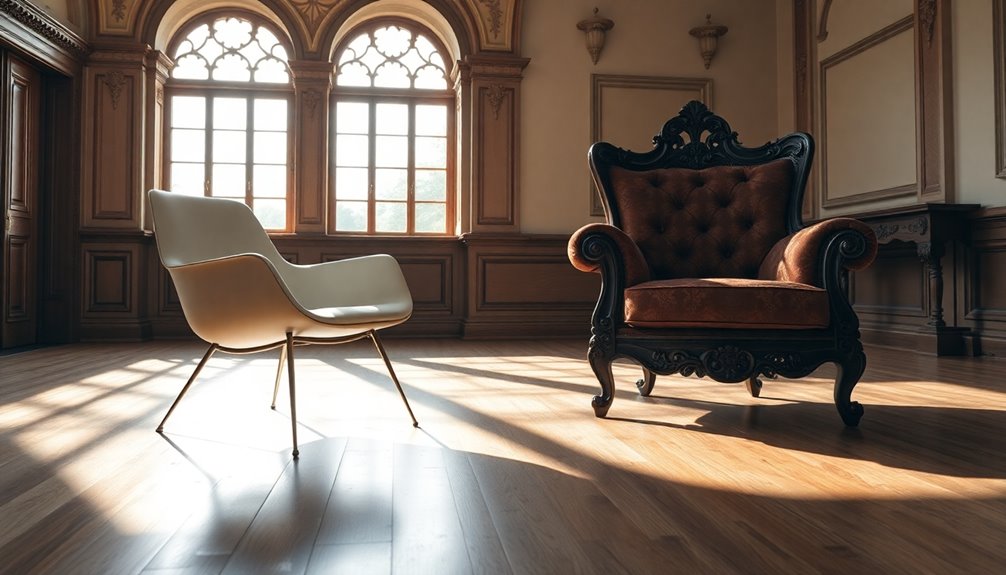
Though modern and classic design styles originate from different eras, their historical contexts profoundly influence each. Classic design reflects craftsmanship from the 18th and 19th centuries, while modern design arose in the early 20th century, driven by industrialization.
| Classic Design | Modern Design |
|---|---|
| Rooted in history | Influenced by innovation |
| Ornate details | Minimalist aesthetics |
| Nostalgic appeal | Contemporary relevance |
| Timeless craftsmanship | Functional simplicity |
The cultural impact of classic design lies in its preservation of historical narratives, whereas modern design shapes contemporary lifestyles, embracing new ideas through innovative materials. As society evolves, these designs reflect differing values and aesthetics, offering unique perspectives on heritage and progress.
Key Characteristics of Classic Design
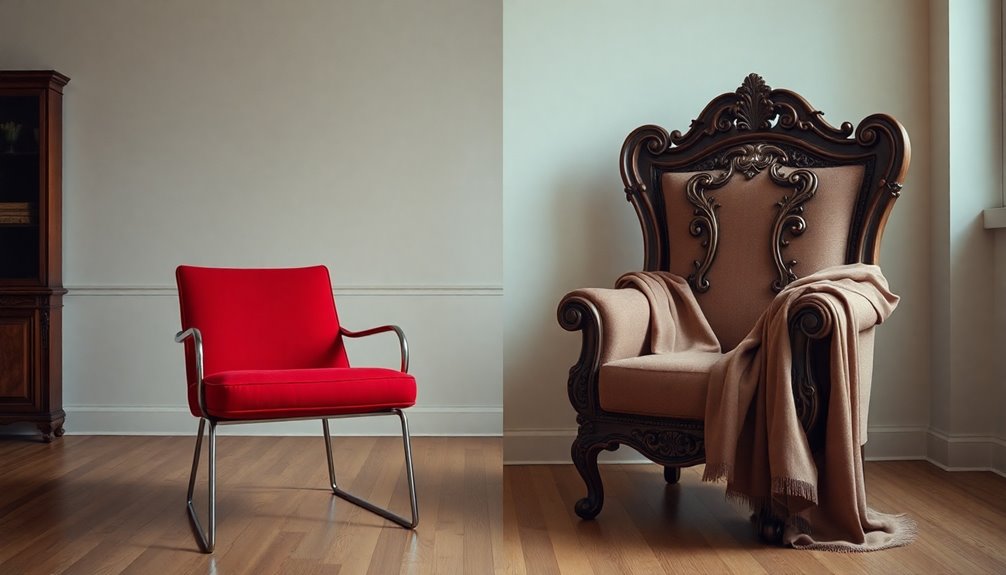
Classic design brings a sense of timeless elegance and comfort to your space, rooted in historical influences and exquisite craftsmanship. Its rich materials and intricate details create an inviting atmosphere that resonates with sophistication. You'll find that this style not only enhances aesthetics but also prioritizes functionality and durability. Additionally, classic design often incorporates natural elements that create warmth and a connection to the outdoors.
Timeless Elegance and Comfort
Elegance and comfort seamlessly intertwine in classic design, drawing inspiration from the refined aesthetics of 18th and 19th-century European décor.
This timeless style embraces symmetry and consistency, fostering a warm and inviting atmosphere that appeals to your sense of nostalgia.
In a classic interior, you'll find rich textures and ornate details, often featuring natural materials like wood and stone.
The color palette typically includes warm neutrals and deep tones, evoking luxury and sophistication.
This approach allows you to personalize your space with unique art pieces and antique furnishings that tell a story.
Ultimately, classic design resonates across generations, creating an enduring aesthetic that remains relevant and cherished in today's homes. Additionally, the incorporation of natural elements promotes tranquility and enhances the overall ambiance.
Historical Influence and Craftsmanship
While appreciating the rich tapestry of history, you'll find that classic design draws heavily from architectural styles and art movements of the 18th and 19th centuries.
This aesthetic showcases exceptional craftsmanship, with intricate details and a focus on symmetry that creates harmonious and inviting spaces. Incorporating natural materials like wood and marble, classic interiors evoke nostalgia and respect for cultural heritage.
The deep, rich color palette, often featuring warm tones, contrasts sharply with modern simplicity, adding a luxurious touch to any environment. This timeless quality appeals to all age groups, allowing for personalization through unique antique pieces and art, ensuring that each space tells its own story while honoring the past.
Key Characteristics of Modern Design
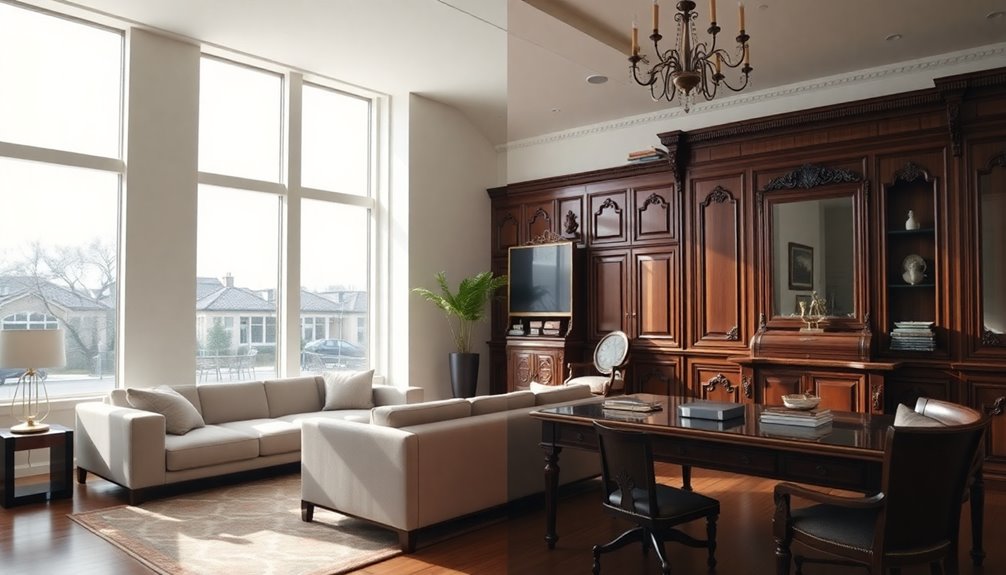
When you think about modern design, you'll notice its minimalist aesthetic that focuses on clean lines and simplicity. It prioritizes functional and practical elements, making spaces not just beautiful but also livable. This approach creates an inviting atmosphere while stripping away the unnecessary. Additionally, modern design often incorporates sustainable materials to promote eco-conscious living and enhance the overall aesthetic.
Minimalist Aesthetic Focus
Modern design embraces a minimalist aesthetic that prioritizes simplicity and functionality.
You'll notice clean lines and functional shapes that eliminate unnecessary clutter, creating a serene environment. The use of a neutral color palette, often featuring warm tones and occasional pops of color, enhances this minimalist approach without overwhelming the space.
In a modern setting, open floor plans promote a sense of light and openness, with large windows maximizing natural illumination.
Innovative materials like metals and glass contribute to an airy feel, reflecting the "less is more" philosophy.
Functional and Practical Elements
Emphasizing functionality and practicality, modern design transforms spaces into usable environments that cater to everyday needs.
You'll notice open layouts that promote ease of movement and interaction, making your life more comfortable. The clean lines and minimal ornamentation streamline the visual experience, reducing clutter in your home.
Innovative materials like steel, glass, and concrete enhance durability while supporting practical applications across various settings.
You'll appreciate multipurpose furniture that adapts to your changing needs, maximizing utility in smaller living spaces.
Furthermore, modern design increasingly incorporates sustainability, focusing on eco-friendly practices and materials that contribute to long-term efficiency and environmental responsibility. Incorporating lighting design can also significantly enhance the ambiance of modern spaces, making them more inviting and functional.
Aesthetic Features and Examples
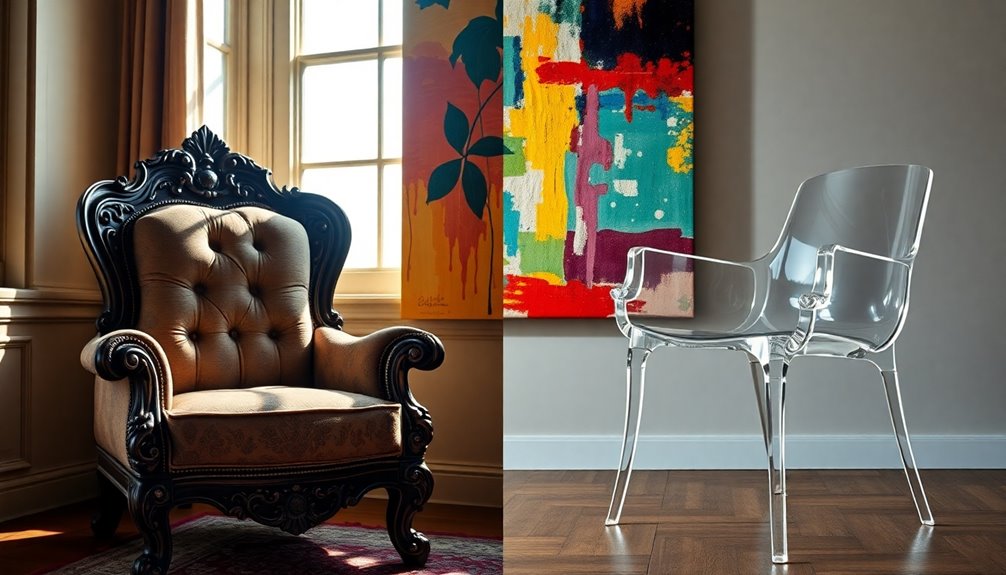
While classic design captivates with its ornate details and rich textures, modern design appeals through its minimalism and clean lines.
Classic design features deep color palettes and intricate craftsmanship, evident in Victorian homes and Baroque art. In contrast, modern design embraces neutral shades and innovative functionality, seen in Bauhaus architecture and Scandinavian aesthetics.
Interior designers often highlight classic interiors with natural materials and symmetrical layouts, while modern spaces focus on open concepts and bold accent colors.
Classic furniture showcases elaborate designs, whereas modern pieces prioritize sleek forms and practicality. The merging of these styles results in a Modern Classic aesthetic, combining contemporary lines with traditional furniture, creating a harmonious look that balances nostalgia and innovation. Modern Farmhouse Decor Trends emphasize the integration of natural materials and sustainability, enhancing both styles.
Current Trends in Design
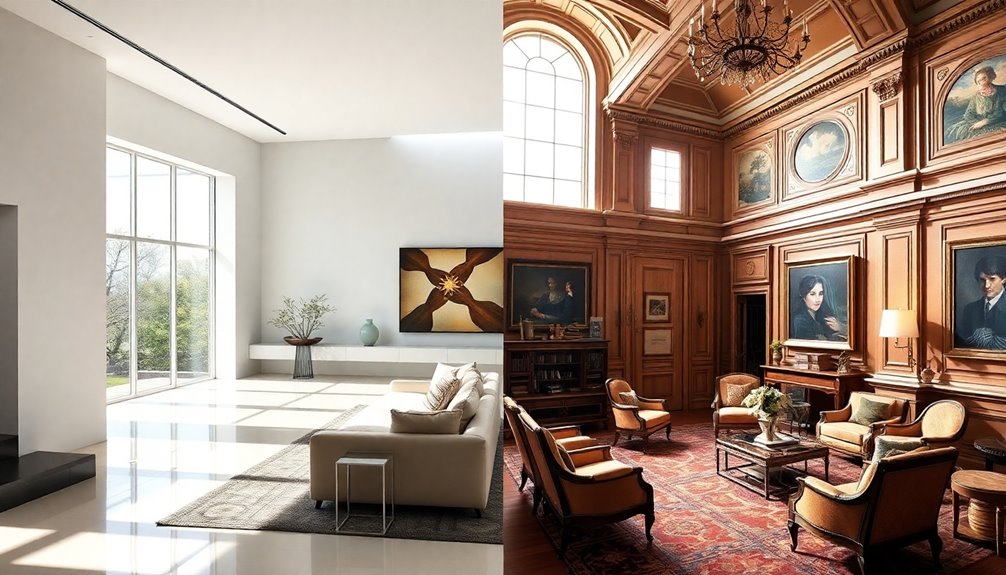
You'll notice that current design trends are all about blending styles effectively, mixing modern minimalism with classic elegance.
Sustainability plays a huge role too, as more designers incorporate eco-friendly materials to create beautiful yet responsible spaces.
This fusion of aesthetics and ethics not only enhances your environment but also reflects your values. Additionally, the integration of smart bathroom technologies is becoming a hallmark of modern design, providing both luxury and efficiency.
Blending Styles Effectively
As designers embrace the current trend of blending modern and classic styles, they're crafting spaces that feel both fresh and timeless.
By blending styles effectively, you can achieve a modern classic style that harmonizes the elegance of traditional elements with contemporary simplicity. A popular approach is using a 3:1 ratio of modern to classic pieces, ensuring your space honors historical craftsmanship while feeling current.
Stick to neutral tones, and don't shy away from incorporating vintage furniture; it adds character and depth, enhancing your design narrative.
Focus on functionality and comfort by selecting quality materials and timeless furniture. The incorporation of natural materials adds warmth and texture, further enhancing the overall aesthetic.
This thoughtful blend creates a nostalgic atmosphere that resonates with a wide audience, making your design both inviting and sophisticated.
Sustainability in Design
Sustainability in design has become a pivotal focus as designers seek to create spaces that not only look good but also protect the environment. Today's trends prioritize eco-friendly materials like reclaimed wood and bamboo, markedly reducing environmental impact. Modern design embraces biophilic elements, incorporating indoor plants and natural light to enhance well-being. Additionally, many designers adopt zero-waste principles, ensuring efficient resource use during production. Energy-efficient appliances and smart technologies align aesthetic choices with sustainable practices. Consumers increasingly support brands that prioritize sustainability, with 66% willing to pay more for eco-friendly products. Furthermore, the integration of solar energy solutions into design can enhance energy efficiency and reduce reliance on traditional power sources.
| Eco-Friendly Materials | Natural Elements | Energy Efficiency |
|---|---|---|
| Reclaimed Wood | Indoor Plants | Smart Appliances |
| Bamboo | Natural Light | Energy Star Rated |
| Recycled Metals | Biophilic Design | Resource Efficiency |
Technology's Role in Design
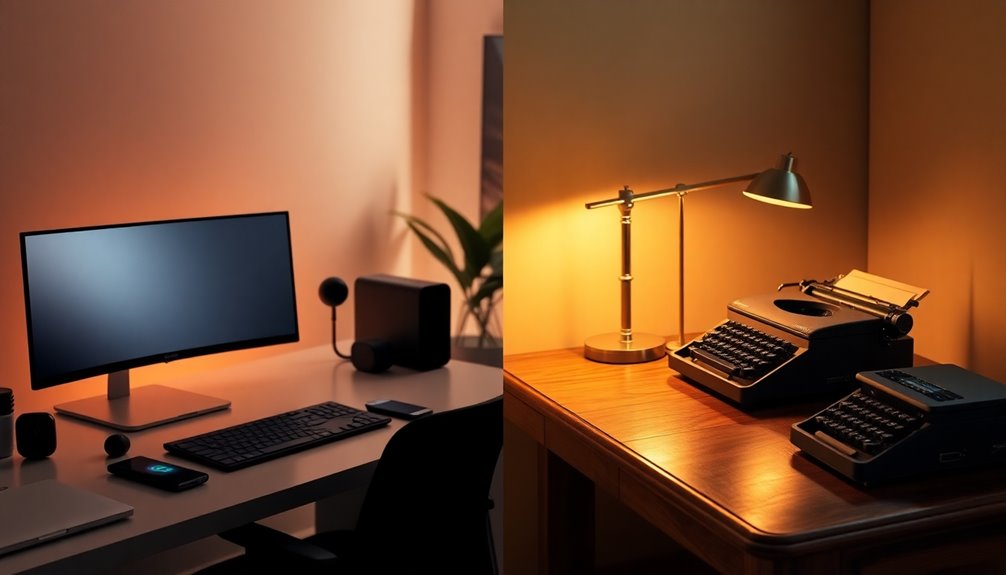
While technology has transformed many aspects of our lives, its impact on design is particularly remarkable.
In modern homes, smart home technology enhances functionality with features like integrated lighting, heating, and entertainment systems. You'll notice how contemporary interior design embraces efficiency, ensuring comfort and ease of use.
Meanwhile, classic design often discreetly incorporates technology, utilizing hidden systems like built-in speakers or custom cabinetry to maintain an elegant aesthetic. This blend allows for modern conveniences without sacrificing tradition.
Innovations like 3D printing and sustainable materials further influence both styles, enabling unique customizations. Additionally, the growing emphasis on noise levels of modern heat pumps reflects a desire for peaceful living environments in both modern and classic homes.
Ultimately, technology plays a pivotal role in contemporary classical design, merging traditional elements with modern advancements to create stylish, functional spaces that cater to your needs.
Sustainability in Modern Design
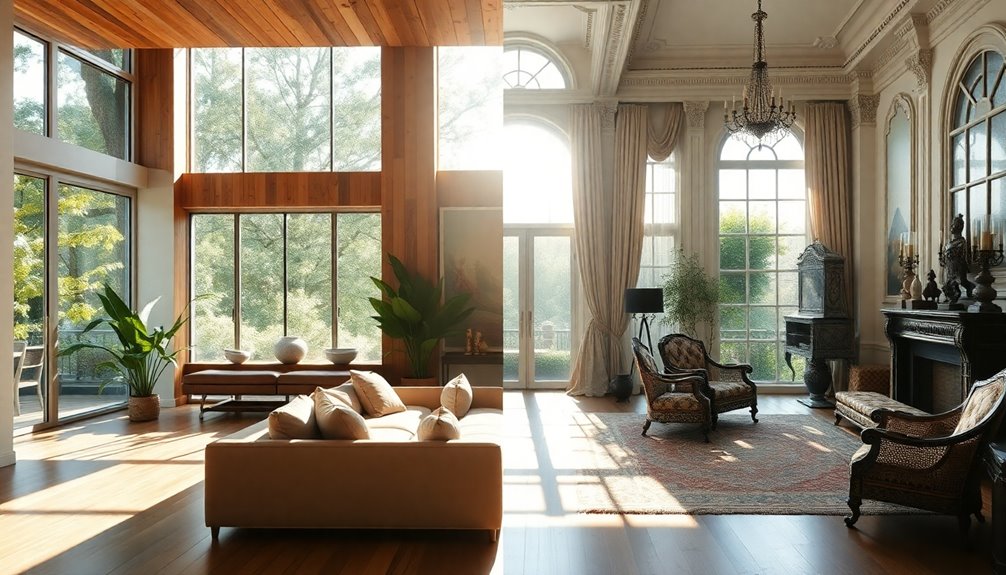
Modern design thrives on eco-conscious principles, integrating sustainable practices that resonate with today's environmentally aware consumers.
By embracing sustainability, you can enhance your space while reducing your ecological footprint. Here are a few key aspects of sustainability in modern design:
- Eco-friendly materials: Incorporate reclaimed wood, bamboo, and recycled metals into your furniture and decor.
- Energy-efficient appliances: Opt for smart home technology that minimizes energy consumption and boosts functionality.
- Natural light: Use large windows and open layouts to decrease reliance on artificial lighting.
- Durable materials: Choose high-quality items that are built to last, reducing waste over time.
Blending Classic and Modern Styles
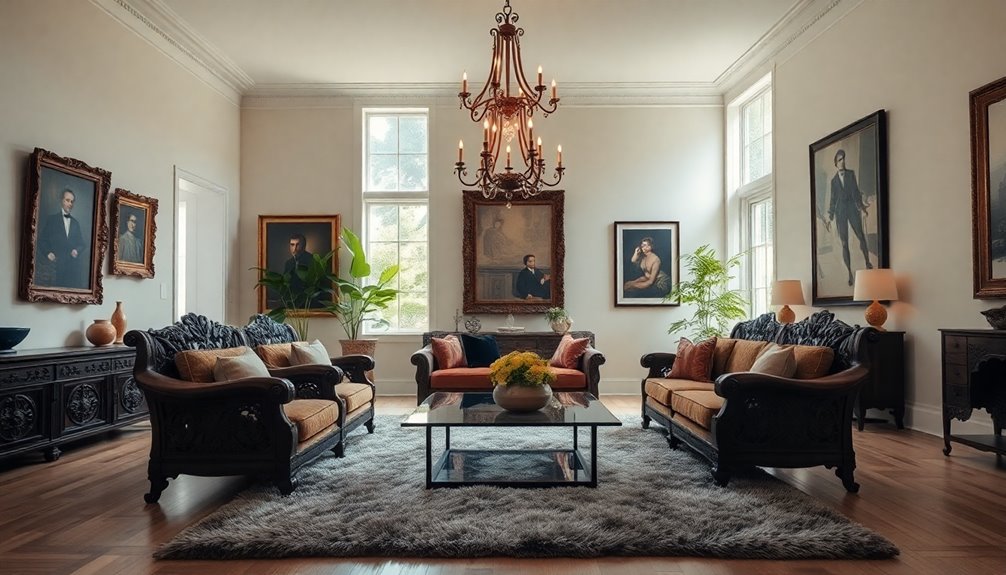
Incorporating sustainability into your design choices opens the door to a harmonious blend of classic and modern styles.
By embracing this Modern Classic approach, you can achieve a timeless aesthetic that balances sleek modern furniture with vintage decor items. Aim for a ratio of about 3/4 modern pieces to 1/4 traditional elements, creating a cohesive look.
Simple patterns and natural materials will enhance your space without overwhelming it. Choose warm neutrals paired with deep tones like navy or warm rust, and use black accents for contrast.
Vintage decor items, such as personal antiques, add a nostalgic touch, seamlessly connecting the old with the new. This thoughtful blend allows for a unique, stylish environment that reflects your personality. Additionally, incorporating energy-efficient appliances can further enhance the sustainability of your modern classic design.
Personalization and Future Directions
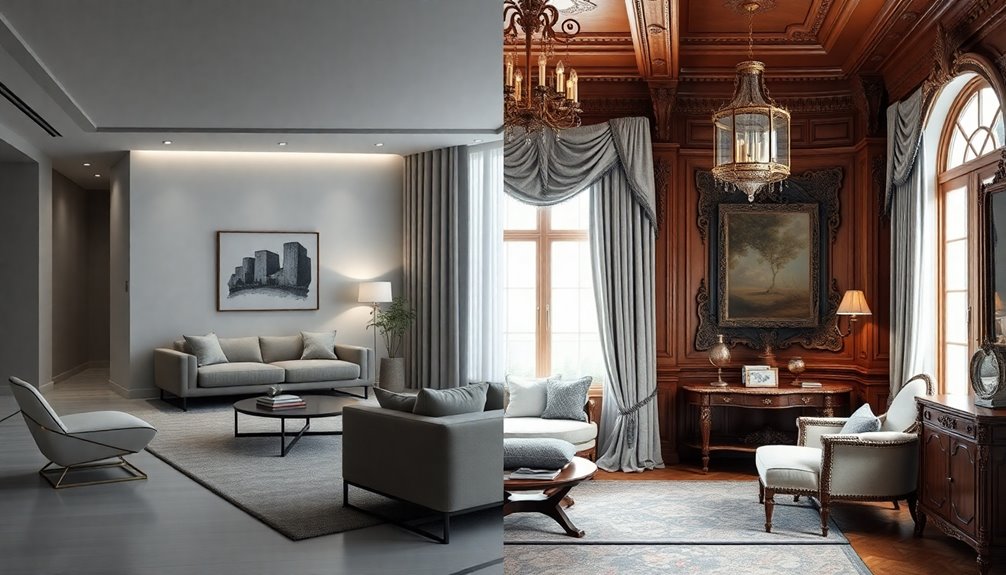
As design continues to evolve, personalization emerges as a key trend that reflects your unique tastes and lifestyle.
You're not just decorating; you're creating a space that feels distinctly yours. Future directions in design highlight eco-friendly practices, hybrid aesthetics, and technology integration.
Here are some trends you might consider:
- Mixing styles: Blend classic elegance with modern minimalism for a timeless yet contemporary feel.
- Sustainable choices: Use reclaimed wood and energy-efficient materials to make eco-friendly decisions.
- Smart homes: Integrate technology for enhanced functionality and aesthetic appeal.
- Vintage accents: Combine vintage decor with modern elements for a personalized touch.
Embracing these trends allows you to create a space that genuinely resonates with who you are.
Frequently Asked Questions
What Is Considered a Classic Design?
Classic design refers to a style that draws inspiration from historical architectural trends, particularly those of the 18th and 19th centuries.
You'll notice ornate details, symmetry, and rich textures that create an inviting atmosphere. Natural materials, elaborate moldings, and traditional furniture often feature prominently.
With a rich color palette and carefully curated art pieces, classic design emphasizes elegance and timelessness, appealing to those who appreciate history and craftsmanship in their spaces.
What Is the Difference Between Modern and Classic Art?
You might think classic art is as timeless as a diamond, while modern art redefines boundaries.
Classic art emphasizes realism, symmetry, and historical themes, showcasing the craftsmanship of masters like Leonardo da Vinci.
In contrast, modern art embraces abstraction and individual expression, often challenging traditional forms. Artists like Picasso push the envelope, reflecting contemporary life and thoughts.
Ultimately, both styles offer unique perspectives, capturing the essence of their respective eras in striking ways.
What Is the Difference Between Modern Style and Old Style?
When you think about modern style versus old style, you notice key differences in aesthetics and functionality.
Modern style embraces minimalism, clean lines, and open spaces, focusing on practicality. In contrast, old style often features ornate details, rich textures, and symmetrical layouts that evoke nostalgia.
While modern designs use natural materials like glass and steel, old styles typically rely on heavy woods and intricate fabrics, showcasing craftsmanship and historical appreciation.
What Defines Modern Design?
Modern design is like a refreshing change, inviting you into spaces that feel open and uncluttered.
You'll notice clean lines and minimal ornamentation, creating a harmonious flow. Natural materials, like wood and stone, warm the environment, while a balanced color palette keeps things inviting.
It emphasizes functionality and comfort, ensuring every piece serves a purpose. By embracing innovative materials and technology, modern design transforms your living experience into something both practical and stylish.
Conclusion
In today's fast-paced world, blending classic and modern design can create spaces that feel both timeless and fresh, like a vintage vinyl spinning on a sleek turntable. By understanding the unique characteristics of each style, you can personalize your environment to reflect your taste. As design continues to evolve, embracing sustainability and technology will shape the future, making your space not just a reflection of the past or present, but a harmonious blend of both.


